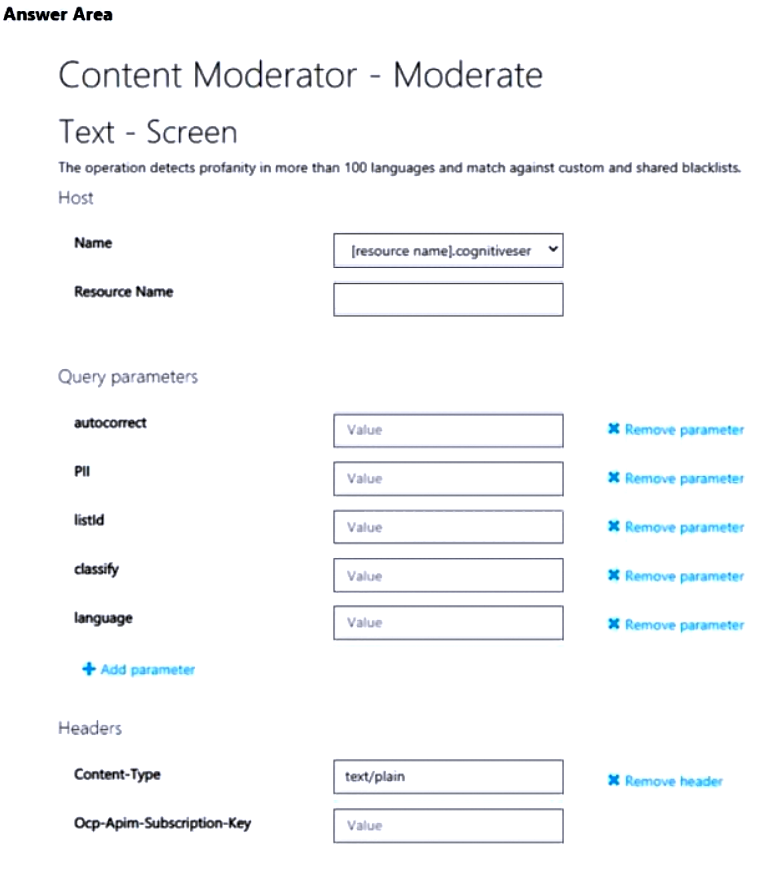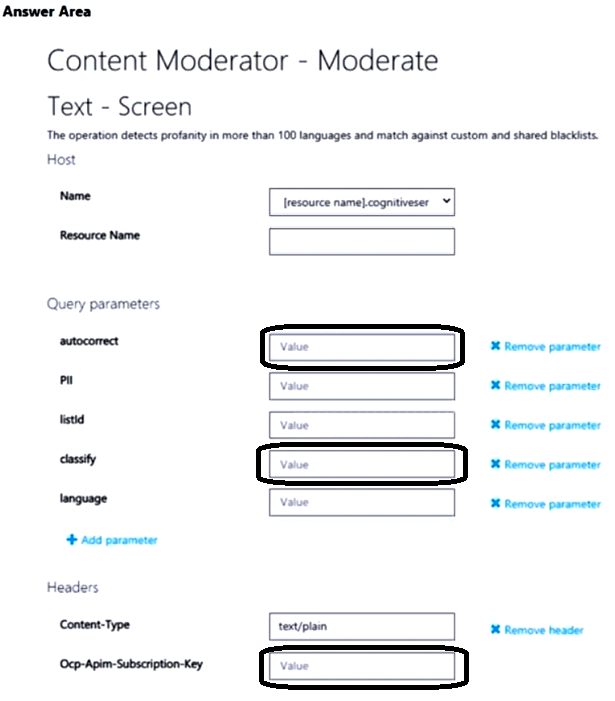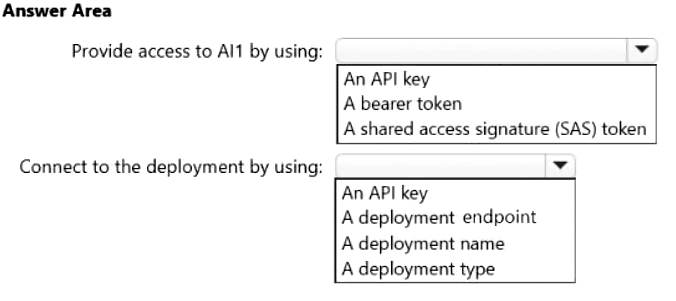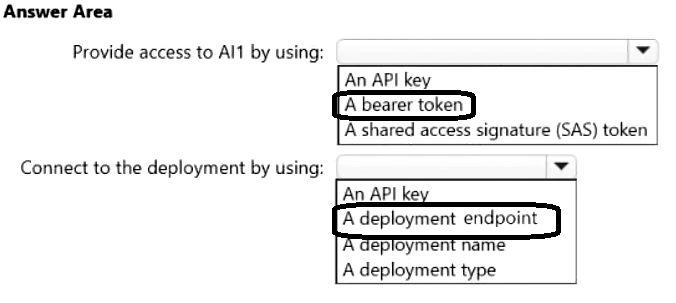Question 1
Note: This question is part of a series of questions that present the same scenario. Each question in the series contains a unique solution that might meet the stated goals. Some question sets might have more than one correct solution, while others might not have a correct solution.
After you answer a question in this section, you will NOT be able to return to it. As a result, these questions will not appear in the review screen.
You have an Azure Cognitive Search service.
During the past 12 months, query volume steadily increased.
You discover that some search query requests to the Cognitive Search service are being throttled.
You need to reduce the likelihood that search query requests are throttled.
Solution: You add replicas.
Does this meet the goal?
- A. Yes
- B. No
Answer:
a
A simple fix to most throttling issues is to throw more resources at the search service (typically replicas for query-based throttling, or partitions for indexing-based throttling). However, increasing replicas or partitions adds cost, which is why it is important to know the reason why throttling is occurring at all.
Reference:
https://docs.microsoft.com/en-us/azure/search/search-performance-analysis
Comments
Question 2
DRAG DROP
You need to analyze video content to identify any mentions of specific company names.
Which three actions should you perform in sequence? To answer, move the appropriate actions from the list of actions to the answer area and arrange them in the correct order.
Answer:

Comments
Question 3
HOTSPOT
You are building a chatbot.
You need to use the Content Moderator API to identify aggressive and sexually explicit language.
Which three settings should you configure? To answer, select the appropriate settings in the answer area.
NOTE: Each correct selection is worth one point.
Answer:

Comments
Question 4
Note: This question is part of a series of questions that present the same scenario. Each question in the series contains a unique solution that might meet the stated goals. Some question sets might have more than one correct solution, while others might not have a correct solution.
After you answer a question in this section, you will NOT be able to return to it. As a result, these questions will not appear in the review screen.
You build a language model by using a Language Understanding service. The language model is used to search for information on a contact list by using an intent named FindContact.
A conversational expert provides you with the following list of phrases to use for training.
Find contacts in London.
Who do I know in Seattle?
Search for contacts in Ukraine.
You need to implement the phrase list in Language Understanding.
Solution: You create a new intent for location.
Does this meet the goal?
- A. Yes
- B. No
Answer:
a
An intent represents a task or action the user wants to perform. It is a purpose or goal expressed in a user's utterance.
Define a set of intents that corresponds to actions users want to take in your application.
Reference:
https://docs.microsoft.com/en-us/azure/cognitive-services/luis/luis-concept-intent
Comments
Question 5
You have the following data sources:
Finance: On-premises Microsoft SQL Server database
Sales: Azure Cosmos DB using the Core (SQL) API
Logs: Azure Table storage
HR: Azure SQL database
You need to ensure that you can search all the data by using the Azure Cognitive Search REST API.
What should you do?
- A. Migrate the data in HR to Azure Blob storage.
- B. Migrate the data in HR to the on-premises SQL server.
- C. Export the data in Finance to Azure Data Lake Storage.
- D. Ingest the data in Logs into Azure Sentinel.
Answer:
c
In Azure Cognitive Search, a data source is used with indexers, providing the connection information for ad hoc or scheduled data refresh of a target index, pulling data from supported Azure data sources.
Note: Supported data sources -
Indexers crawl data stores on Azure and outside of Azure.
Amazon Redshift (in preview)
Azure Blob Storage -
Azure Cosmos DB -
Azure Data Lake Storage Gen2 -
Azure MySQL (in preview)
Azure SQL Database -
Azure Table Storage -
Elasticsearch (in preview)
PostgreSQL (in preview)
Salesforce Objects (in preview)
Salesforce Reports (in preview)
Smartsheet (in preview)
Snowflake (in preview)
Azure SQL Managed Instance -
SQL Server on Azure Virtual Machines
Azure Files (in preview)
Reference:
https://docs.microsoft.com/en-us/azure/search/search-indexer-overview#supported-data-sources
Comments
Question 6
You have an Azure subscription that contains an Azure App Service app named App1.
You provision a multi-service Azure Cognitive Services resource named CSAccount1.
You need to configure App1 to access CSAccount1. The solution must minimize administrative effort.
What should you use to configure App1?
- A. a system-assigned managed identity and an X.509 certificate
- B. the endpoint URI and an OAuth token
- C. the endpoint URI and a shared access signature (SAS) token
- D. the endpoint URI and subscription key
Answer:
d
Comments
Question 7
Note: This question is part of a series of questions that present the same scenario. Each question in the series contains a unique solution that might meet the stated goals. Some question sets might have more than one correct solution, while others might not have a correct solution.
After you answer a question in this section, you will NOT be able to return to it. As a result, these questions will not appear in the review screen.
You are building a chatbot that will use question answering in Azure Cognitive Service for Language.
You have a PDF named Doc1.pdf that contains a product catalogue and a price list.
You upload Doc1.pdf and train the model.
During testing, users report that the chatbot responds correctly to the following question: What is the price of
The chatbot fails to respond to the following question: How much does
You need to ensure that the chatbot responds correctly to both questions.
Solution: From Language Studio, you create an entity for price, and then retrain and republish the model.
Does this meet the goal?
- A. Yes
- B. No
Answer:
b
Comments
Question 8
You are building a bot by using Microsoft Bot Framework.
You need to configure the bot to respond to spoken requests. The solution must minimize development effort.
What should you do?
- A. Deploy the bot to Azure and register the bot with a Direct Line Speech channel.
- B. Integrate the bot with Cortana by using the Bot Framework SDK.
- C. Create an Azure function that will call the Speech service and connect the bot to the function.
- D. Deploy the bot to Azure and register the bot with a Microsoft Teams channel.
Answer:
b
Comments
Question 9
Note: This question is part of a series of questions that present the same scenario. Each question in the series contains a unique solution that might meet the stated goals. Some question sets might have more than one correct solution, while others might not have a correct solution.
After you answer a question in this section, you will NOT be able to return to it. As a result, these questions will not appear in the review screen.
You create a web app named app1 that runs on an Azure virtual machine named vm1. Vm1 is on an Azure virtual network named vnet1.
You plan to create a new Azure Cognitive Search service named service1.
You need to ensure that app1 can connect directly to service1 without routing traffic over the public internet.
Solution: You deploy service1 and a public endpoint to a new virtual network, and you configure Azure Private Link.
Does this meet the goal?
- A. Yes
- B. No
Answer:
b
The Azure Private Link should use a private endpoint, not a public endpoint.
Private Link service can be accessed from approved private endpoints in any public region.
Reference:
https://docs.microsoft.com/en-us/azure/private-link/private-link-overview
Comments
Question 10
HOTSPOT
You have an Azure OpenAI resource named AI1 that hosts three deployments of the GPT 3.5 model. Each deployment is optimized for a unique workload.
You plan to deploy three apps. Each app will access AI1 by using the REST API and will use the deployment that was optimized for the app's intended workload.
You need to provide each app with access to AI1 and the appropriate deployment. The solution must ensure that only the apps can access AI1.
What should you use to provide access to AI1, and what should each app use to connect to its appropriate deployment? To answer, select the appropriate options in the answer area.
NOTE: Each correct selection is worth one point.
Answer:

Comments
Page 1 out of 28
Viewing questions 1-10 out of 284
page 2